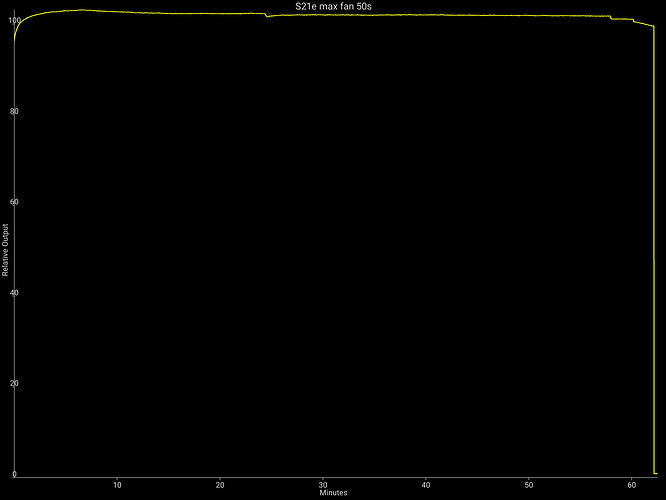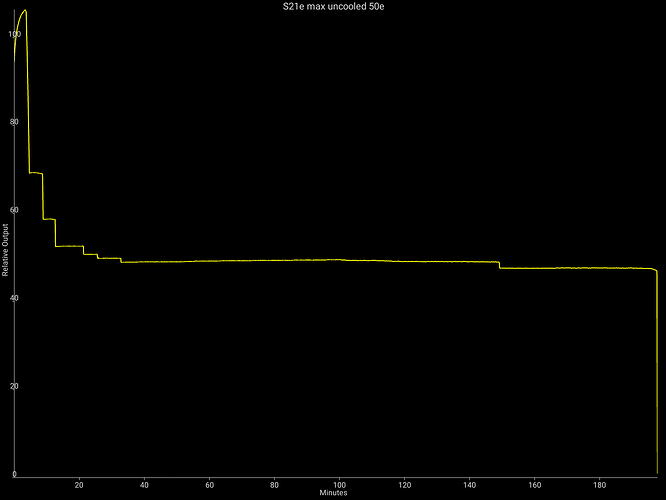2023-11-13

A multi-die LED from Nichia, the B35AM, has been available since 2019. Due to the lack of a dome, it is to some extent a competitor to the XHP35 HI or the newer XHP50.3 HI model, and it is also available in CRI 90 at up to 6500 K, which is also unusual by Nichia standards. This test clarifies to what extent this LED also performs at higher currents and whether it can really keep up with an XHP50.3 HI.
The emitter tested here, including the LED board, was made available to me for this test by BLF user @thefreeman. Many thanks for that!
Tj 25 °C, If 1,400 mA
- Type: multi-die, 2S2P
- Bin: E900
- Color group: sm653 (6500K)
- CRI: min. 90 - R9 min. 80
- Rated voltage: 5.93 V
- Max. Forward current: 1,800 mA
- Max. Peak current: 2,400 mA
- Viewing angle: unknown °
- Thermal resistance: min. 1.5 - max. 2.8 K/W
- Max. Temperature Tj: max. 150°C
Datasheet can be downloaded here: [Datasheet (newest version, Nichia)] (https://led-ld.nichia.co.jp/api/data/spec/led/NV4WB35AMT-E(5768D)R70%20R8000%20R9080.pdf)
The B35AM is a flat LED without a dome. The four recognizable LED chips are surrounded by white silicone and protrude only slightly. The gray substrate corresponds to that of other Nichia LEDs.
The large illuminated area compared to the size of the LED itself is striking. The edges around the illuminated area are very small so that the footprint area is used as efficiently as possible.
The B35AM is 3.65 x 3.65 mm in size. The format is therefore not compatible with standard dimensions, which can be a problem depending on the application and accessories required.



Due to the unusual dimensions, centering rings for XP or 3535 LEDs cannot be used directly. Thanks to the symmetrical housing, centering rings produced using a lathe can at least be used. I recommend custom-made centering aids using 3D printing or a lathe, or the use of other centering methods or TIR lenses.

The footprint is also unusual. Unlike most emitters in this performance class, there is no dedicated thermal pad. This is likely to limit the maximum performance. A board with the lowest possible thermal resistance of the contacts or a reduced operating current is therefore essential for this LED. This LED was tested on an LED board from ‘Eurekatronix’ (Clemence), which has the lowest possible thermal resistance under the contacts.
It should be noted here that this special LED board does not correspond to the standard dimensions of other 20mm boards and in particular the recesses for screw mounting had to be subsequently widened.
Thanks to the very closely spaced segments (LED chips) and the densely applied phosphor, almost no gaps are visible. Darker areas are only visible at the edges and in the middle, but these should not impair the optical properties.
The segments are connected as flip chips, there are no visible bonding wires.

The luminous area is 9.83 mm² in size. This value is very close to the 9.73 mm² specified by Nichia (3.12 x 3.12 mm illuminated area).
After operation at the maximum possible operating current, the luminous surface was minimally damaged (red circle in the following picture). Although the phosphor was not burnt, it is therefore not advisable to operate at the maximum possible current, even if this effect should not necessarily occur with every B35AM and is possibly also dependent on the CRI, because this is a factor for the thickness of the phosphor layer, among other things.
However, operation at 3-3.5 A should avoid this problem for longer periods of continuous operation.


Within official parameters, as far as known:
- at 1,800 mA (official maximum current): 1227 lm @ 5.86 V
- Power at official maximum: 10.6 W
- Efficiency at 1,800 mA: 116.4 lm/W
This LED is a good sample. Not only does it achieve the higher flux binning E1000 (1000 lm @ 1.4 A), but the Vf is also very low and below the typical values specified by Nichia.
Overcurrent:
- Maximum reached at 5.0 A, at this point 2521 lm @ 6.24 V
- Power at maximum 31.2 W
- Sweet spot at about 3.4 A (2031 lm @ 6.09 V)
- Power at sweet spot 20.7 W
- Efficiency at maximum 80.8 lm/W
- Efficiency in the sweet spot 98.2 lm/W
This LED behaves strangely when overcurrent is applied. Up to around 4.4 A, the curve behaves normally and rises as is already known from other LEDs, before suddenly flattening out and then ending as a plateau just 600 mA later (at 5.0 A). For me, this indicates a massive heat build-up, which occurs despite the LED board being as ideal as possible and low thermal resistance due to the lack of a thermal pad. It is likely that this point is reached much earlier with less high-quality LED boards.
The 719A also has this characteristic curve, but it is much less pronounced.
The B35AM is therefore not suitable for high-performance applications with thousands of lumens of luminous flux. If Nichia were to equip the B35AM with a thermal pad to eliminate the heat build-up, it would probably (estimated) achieve over 4500 lumens and 11-13 A max. current! (This is assuming no damage to the light surface).

Interestingly, the B35AM tested here is more efficient than the XHP50.3 HI, also in 90 CRI, but this could be also only due to the high CCT of 6500 K. The 719AC has no chance at all, which is due to its high thermal resistance because of the stacked LED chips.
However, the SFT-70-X is a surprise. Although it has 70 CRI at the highest CCT, at 7 A it is only 15-20 % more efficient than the XHP50.3, although the latter achieves the same luminous flux at a higher maximum current later on. However, it must be keep in mind that the XHP50.3 is not stable at the maximum possible operating current and quickly shows damage on the phosphor (see test).
In general, the B35AM has little chance against other emitters due to the lack of a thermal pad and the resulting low maximum output. As already mentioned, if Nichia were to massively improve the heat dissipation of the four LED chips, as would be possible with a dedicated thermal pad, it would in principle match or even slightly outperform the XHP50.3 in 90 CRI!

The comparison with a Getian GT-FC40 has been requested several times. I normally avoid such direct comparisons of different LED types (Vf classes), as this can quickly become misleading, as the following differences must be taken into account:
-
The GT-FC40 is a 12 V LED
-
The GT-FC40 has a huge thermal pad (7070 footprint)
-
The GT-FC40 has a considerably larger illuminated area with significantly more chips connected in parallel/serially (4S-4P)
As a result, the possible total output of the GT-FC40 is almost 5 (!) times higher at over 150 W, despite the same color rendering rating.
Values at 25 °C Tsp, at 85 °C Tsp values are 13 % lower

The luminance is low, a 519A with dome is only just surpassed, seen at maximum current. Due to the large illuminated area and the low maximum current possible, it is not worth mentioning. The LED is perfect for a good all-rounder, but it is not suitable for a thrower despite the lack of a dome.
The luminance was calculated for 5 A in order to prevent further possible damage to the illuminated surface.

The light pattern is perfect. There are no disturbing color distortions or rings. The latter can only occur with poorly calculated reflectors. This LED is perfect for all those who value an optimum light pattern!

Despite the slightly greenish color localization according to the Nichia data sheet, the tint of this sample is good. The green tint is very low and the tint is also suitable for more demanding users without any problems. However, this LED is definitely of the colder variety, with almost 7400 K. However, this makes this LED unique again, as such a high CCT combined with extremely high color rendering is very rare and makes this LED suitable for daylight lighting (color temperature of an overcast sky).
Otherwise there are no surprises, the Nichia specifications for Ra (min. 90 ) and R9 (min. 80) are met without any problems, and the extremely high R9 is also in line with the SFT-40 3000 K and Getian FC-40.
- Ra: 96
- R9: 99
- CCT: 7370 K
- duv: 0.0019
The B35AM is an ambivalent LED. I like the extremely good light quality typical of Nichia in optics, without any artifacts, and the extremely high color rendering with a very cold color temperature, which opens up new possibilities, especially in the field of daylight lamps.
However, this emitter also gets in its own way.
The biggest drawback is the lack of a thermal pad and the unusual footprint, which limits the maximum possible output. There is also a risk of permanent damage to the LES if the emitter is operated at maximum power for long periods. The luminance is also relatively low as a result, but this is only a disadvantage for thrower applications.
All in all, a very good LED with excellent light quality if a good all-rounder is required, but only if light output is not the main priority.
Pro
- Perfect light image in reflectors and lenses without artifacts
- very high CRI
- available in many different CCTs and Ra
Neutral
- Relatively low luminance
Contra
- no dedicated thermal pad
- unusual footprint, unusual dimensions
- Limited maximum output
Thank you for reading the test. ![]()

